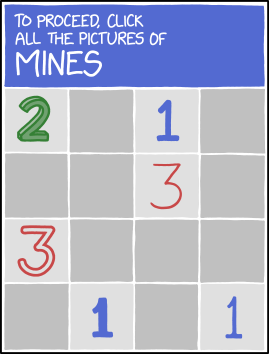Mine Captcha

This data is actually going into improving our self-driving car project, so hurry up--it's almost at the minefield.

This data is actually going into improving our self-driving car project, so hurry up--it's almost at the minefield.
This comic, like 1897: Self Driving, references the approach of using human-entered CAPTCHA inputs to solve machine learning problems, particularly those involving image classification.
In order to prevent automated programs from using web services, Google offers a protection called reCAPTCHA, which performs various tests to see if a user is human or machine. One of these tests is a "I'm not a robot" checkbox which must be checked in order to proceed, although ticking the box is merely a formality, and later versions of reCAPTCHA can simply perform the tests quietly in the background without needing user consent.
If the reCAPTCHA system suspects that the user may be an automated bot, it presents an image recognition challenge that only humans should be able to pass. This has the desired effect of denying access to robots, but it also has a side benefit that the human input can be used to train Google's image recognition software. The challenge usually features a square grid of images, typically things one might see while driving - e.g. "Check all squares containing a stop sign". If the user clicks enough correct squares, they are permitted to continue.
Minesweeper, on the other hand, is a logic puzzle game in which the player is presented with a grid of unrevealed squares and must deduce the location of mines that have been secretly hidden on random squares. The game provides clues by marking some squares with the number of mines (up to a maximum of 8) that are adjacent to that square; by carefully considering the possibilities, a player can deduce which squares must contain mines, and mark them with flags to avoid clicking on them. Revealing a mine loses the game.
In this comic, Randall combines the two concepts to create a "Mine Captcha", which is presented in the form of a reCAPTCHA challenge but actually appears to be a mini game of Minesweeper. To be more precise, it is actually the opposite of regular Minesweeper. This challenge invites the user to click on the mines, as opposed to Minesweeper's aim of clicking only upon unrevealed squares that are not mines. Furthermore, within the terms of a reCAPTCHA, there are no pictures of mines displayed, to click upon. This is also the case for Minesweeper, as they only appear once the game ends, all remaining hidden during play and thus needing to be deduced where they all are.
A real-world Mine Captcha would be somewhat ineffective for a variety of reasons. Firstly, not every human would recognize a game of Minesweeper and therefore wouldn't understand what they are being asked to do. Even if they do recognize the game, they may not know the logical method for deducing the locations of mines. Additionally, even for skilled players, there is a trap in that the Captcha's objective is the reverse of regular Minesweeper; they might therefore get tripped up by muscle memory and click on something that is not a mine, which would fail the challenge.
Another issue is that games of Minesweeper can sometimes involve a degree of luck, as it is possible to generate a puzzle which does not give sufficient information to unambiguously deduce the location of every mine. This may not be a problem since Randall's Minesweeper is only a four-by-four grid. In these situations, the most a player can do is click the uncertain square and hope for the best. If the Mine Captcha is poorly implemented in this way, this would increase false negatives in human detection due to some humans failing the captcha purely due to bad luck. Some variants attempt to eliminate this problem: Mine Detector, for example, is a variant game which provides better information, such that it's almost always solvable without guessing except at the highest difficulty level.
Finally, a Mine Captcha would actually be fairly easy for an artificial intelligence to solve, since it is a logic puzzle: as long as the AI can read the numbers, it can simply use an algorithm to eliminate all impossibilities until it has the correct answer. With a 4x4 grid it's even easier than that: a computer could quickly brute force the problem by trying every possible arrangement of mines until it has the correct one.
It seems that Randall predicted that an AI might try to solve the captcha itself, as he rendered each numeral in a different style; this is similar to obfuscation methods used in text-based captchas to prevent automatic text recognition software from reading the captcha. However, it would not be very effective in this case as the same numbers have the same color; an AI could simply recognize the color instead, which is even easier for an AI than trying to read a number.
The title text is similar to 1897: Self Driving where the CAPTCHA solver is asked to answer quickly, implying that the training data is actually a real-world situation being experienced by a self-driving vehicle at that very moment. The joke here is that real-life minefields do not have large numbers indicating which of the surrounding land contains mines[citation needed].